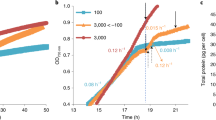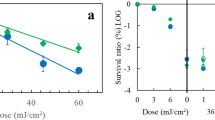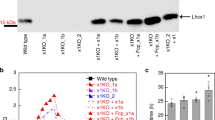Abstract
CYANOBACTERIA are believed to have been precursors to eukaryotes during Precambrian evolution1. It is also suggested that the oxygen evolved as a result of photosynthetic activity in these organisms, several of which are obligate photoautotrophs, was the major contributor towards the transition from anaerobic to aerobic atmosphere1,2. It is, therefore, reasonable to expect cyanobacteria to have evolved in an environment with a relatively high flux of solar ultraviolet light in the absence of ozone shield. This, presumably, could be possible with the evolution of efficient protective mechanisms or repair systems effective against damage by ultraviolet light. It is therefore not surprising that these organisms possess an extremely efficient photoreactivating repair system3. The presence of dark-repair in Anacystis nidulans has also been suggested by the isolation of mutants sensitive to ultraviolet light4. We present here physiological evidence for a dark-repair (or protective) system in this organism. A protein, unstable at least in the light, seems to be responsible for the resistance against lethal damage by ultraviolet light. This is observable in conditions of reduced photoreactivation achieved by a 24 h post-irradiation dark incubation, referred to here as ‘dark-survival’ following Asato, who showed that well within this period photoreactivability of damage by ultraviolet light is almost completely lost4.
This is a preview of subscription content, access via your institution
Access options
Subscribe to this journal
Receive 51 print issues and online access
$199.00 per year
only $3.90 per issue
Buy this article
- Purchase on Springer Link
- Instant access to full article PDF
Prices may be subject to local taxes which are calculated during checkout
Similar content being viewed by others
References
Schoff, J. W. Biol. Rev. 45, 319–352 (1970).
Margulis, L., Walder, J. C. G. & Rambler, M. Nature 264, 620–624 (1976).
Van Baalen, C. Pl. Physiol. 43, 329–333 (1968).
Asato, Y. J. Bact. 110, 1058–1064 (1972).
Van Baalen, C. J. Phycol. 3, 154–157 (1967).
Bhattacharjee, S. K. & David, K. A. V. Nature 265, 183–184 (1977).
Heude, M., Chanet, R. & Moustachi, E. Mutat. Res. 28, 37–45 (1975).
Witkin, E. M. Genetics 79,, 199–213 (1975).
Sedgwick, S. G. Nature 255, 349–350 (1975).
McEntee, K., Hesse, J. E. & Epstein, W. Proc. natn. Acad. Sci. U.S.A. 73, 3979–3983 (1976).
Chatterjee, S. & Bhattacharjee, S. K. Nature 259, 676–677 (1976).
Murphy, T. M. & Gordon, M. P. Photochem. Photobiol. 13, 45–55 (1971).
Author information
Authors and Affiliations
Rights and permissions
About this article
Cite this article
BHATTACHARJEE, S. Unstable protein mediated ultraviolet light resistance in Anacystis nidulans. Nature 269, 82–83 (1977). https://doi.org/10.1038/269082a0
Received:
Accepted:
Issue Date:
DOI: https://doi.org/10.1038/269082a0
This article is cited by
-
A homozygous recA mutant of Synechocystis PCC6803: construction strategy and characteristics eliciting a novel RecA independent UVC resistance in dark
Molecular Genetics and Genomics (2005)
Comments
By submitting a comment you agree to abide by our Terms and Community Guidelines. If you find something abusive or that does not comply with our terms or guidelines please flag it as inappropriate.



